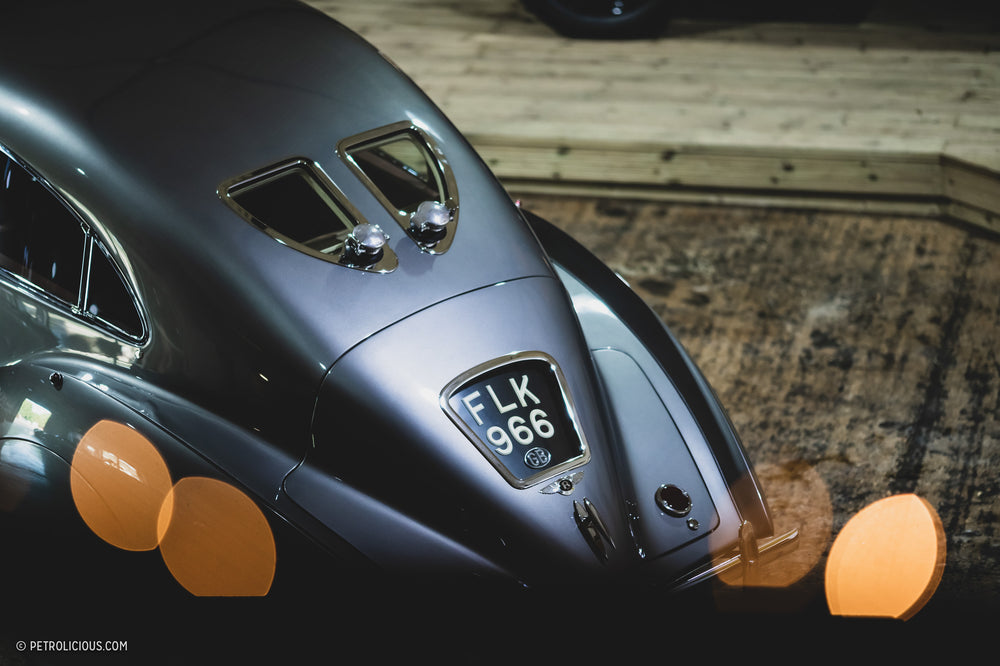In my work, I am extremely fortunate to come across some incredible bits of classic machinery, but occasionally one sees a car that is just achingly pretty. Of course, beauty is absolutely in the eyes of the beholder, but I’m sure we all understand what it is to have been left open mouthed and breathless by a car—when your subjective opinion seems all but fact. I had just such an experience around a year ago, when exploring the showroom at The Classic Motor Hub and my eyes first came to rest on the Bentley Embiricos tribute, tucked away at the back of the hangar. It was love at first sight, and I have been trying to set up a photoshoot ever since…



The original Embiricos was built for Greek businessman and prolific racing driver, Andre Embiricos, who in the 1930s wanted to purchase a custom-built car for the road. The Greek, who was residing in Paris at the time, was put in touch with Georges Paulin, after inquiring about the possibility of a bespoke machine with a local Bentley rep. Paulin, chief designer for coachbuilder Carrossier Pourtout, put Embiricos’ ideas into action, producing the extraordinary swept back lines of the car’s body and mating it to the chassis of a 4 ¼-liter Bentley Derby. That car became known as the 4 ¼ Embiricos Special, and only one example was ever built. It went on to not only compete in three post-war 24 Hours of Le Mans races—achieving a best finish of sixth—but it also influenced future Bentley production models, such as the 1952 R Type Continental.
The model housed within the walls of the Hub is of course a recreation of that extraordinary original machine, but I feel that it’s no less deserving of the adulation and reaction the original created all those years ago. It is exquisite in its replication, based upon the correct 4 ¼ Bentley Derby chassis, and with the most wonderful coachwork mirroring the original line for line, crafted in this case by Bob Peterson Engineering. There are no words that sufficiently describe the lines of Embiricos: it is as imperious as it is beautiful, and like all majestic pieces of design, it is almost impossible to label without becoming effusive. It could be as much a piece of architecture as an automobile, it’s a symphonic collection of shapes, and it’s utterly impossible to find an angle that I’m not utterly in love with.




Of course, the original Embiricos could play a tune as well; the form also provided function, extensively tested as it was in wind tunnels across Britain and France, and with this inch-perfect recreation using the same running gear, it is sure to match what was reputedly one of the fastest pre-war saloons. If the coachwork is the cathedral, then the 126bhp 4257cc inline-six is the organ that pipes out the signature Bentley purr. It is of course the same power plant that was at the heart of the original, fed by two SU carbs and transmitting power to the rear wheels via a four-speed ‘box. This example, W9BC, is the original motor for the chassis, and retains its original registration.



It isn’t the engine or performance figures that interest me though, although if I were ever one of the lucky few that got to pilot this car, my opinion on that may change. For me it’s the exquisite lines that speak to a part of my soul that few other cars can reach. From the obvious tear drop shapes of the wings and light enclosures that look something akin to an illustration from a Tin-Tin cartoon, the car draws you in and bears the glorious hallmarks of the most stunning stream-liner locomotives of the same decade, such as 6325 City of Birmingham, that was built in Crewe, the same location of the Bentley factory that supported the original Embiricos build.




For those who take the time to look closer, the machine rewards inquisitive eyes with sublime details. Little touches like the recessed door handles, the shadows cast on the interior through the split rear window, and dual Monza-style filler caps keep a permanent grin on my captivated face as I gulp it in. Even poking my head around the engine bay provides optical treats as the lights of the hangar probe through the vented grill that sits proudly at the front of the machine.










Unfortunately, my snatched morning of indulgence with the car must come to an end, but I am in no doubt that it is one of the most striking objects I’ve ever had the pleasure of photographing, and one of the most difficult as well. You see it is almost impossible to do it justice, and I feel like the tortured artist, trying to recreate a form that is already perfect. Thankfully though, the pleasure of poring over the details of such a car outweighs the anguish of trying to give it its due, and while I am always a staunch advocate that cars and motorcycles should be driven, this is one that I can very much enjoy standing still.
































































